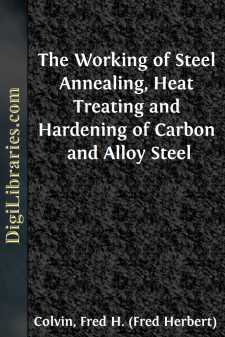Categories
- Antiques & Collectibles 13
- Architecture 36
- Art 48
- Bibles 22
- Biography & Autobiography 813
- Body, Mind & Spirit 142
- Business & Economics 28
- Children's Books 15
- Children's Fiction 12
- Computers 4
- Cooking 94
- Crafts & Hobbies 4
- Drama 346
- Education 46
- Family & Relationships 57
- Fiction 11828
- Games 19
- Gardening 17
- Health & Fitness 34
- History 1377
- House & Home 1
- Humor 147
- Juvenile Fiction 1873
- Juvenile Nonfiction 202
- Language Arts & Disciplines 88
- Law 16
- Literary Collections 686
- Literary Criticism 179
- Mathematics 13
- Medical 41
- Music 40
- Nature 179
- Non-Classifiable 1768
- Performing Arts 7
- Periodicals 1453
- Philosophy 64
- Photography 2
- Poetry 896
- Political Science 203
- Psychology 42
- Reference 154
- Religion 513
- Science 126
- Self-Help 84
- Social Science 81
- Sports & Recreation 34
- Study Aids 3
- Technology & Engineering 59
- Transportation 23
- Travel 463
- True Crime 29
The Working of Steel Annealing, Heat Treating and Hardening of Carbon and Alloy Steel
Categories:
Description:
Excerpt
Page ix INTRODUCTION
THE ABC OF IRON AND STEEL
In spite of all that has been written about iron and steel there are many hazy notions in the minds of many mechanics regarding them. It is not always clear as to just what makes the difference between iron and steel. We know that high-carbon steel makes a better cutting tool than low-carbon steel. And yet carbon alone does not make all the difference because we know that cast iron has more carbon than tool steel and yet it does not make a good cutting tool.
Pig iron or cast iron has from 3 to 5 per cent carbon, while good tool steel rarely has more than 1¼ per cent of carbon, yet one is soft and has a coarse grain, while the other has a fine grain and can be hardened by heating and dipping in water. Most of the carbon in cast iron is in a form like graphite, which is almost pure carbon, and is therefore called graphitic carbon. The resemblance can be seen by noting how cast-iron borings blacken the hands just as does graphite, while steel turnings do not have the same effect. The difference is due to the fact that the carbon in steel is not in a graphitic form as well as because it is present in smaller quantities.
In making steel in the old way the cast iron was melted and the carbon and other impurities burned out of it, the melted iron being stirred or "puddled," meanwhile. The resulting puddled iron, also known as wrought iron, is very low in carbon; it is tough, and on being broken appears to be made up of a bundle of long fibers. Then the iron was heated to redness for several days in material containing carbon (charcoal) until it absorbed the desired amount, which made it steel, just as case-hardening iron or steel adds carbon to the outer surface of the metal. The carbon absorbed by the iron does not take on a graphitic form, however, as in the case of cast iron, but enters into a chemical compound with the iron, a hard brittle substance called "cementite" by metallurgists. In fact, the difference between the hard, brittle cementite and the soft, greasy graphite, accounts for many of the differences between steel and gray cast iron. Wrought iron, Page x which has very little carbon of any sort in it, is fairly soft and tough. The properties of wrought iron are the properties of pure iron. As more and more carbon is introduced into the iron, it combines with the iron and distributes itself throughout the metal in extremely small crystals of cementite, and this brittle, hard substance lends more and more hardness and strength to the steel, at the expense of the original toughness of the iron. As more and more carbon is contained in the alloy—for steel is a true alloy—it begins to appear as graphite, and its properties counteract the remaining brittle cementite. Eventually, in gray cast iron, we have properties which would be expected of wrought iron, whose tough metallic texture was shot through with flakes of slippery, weak graphite.
But to return to the methods of making steel tools in use 100 years ago....


